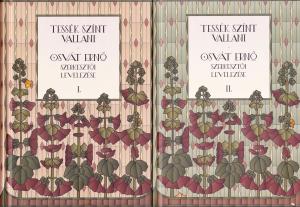
Speak out. Editorial correspondence of Ernő Osvát I-II.
Tessék színt vallani. Osvát Ernő szerkesztői levelezése I-II. (Speak out. Editorial correspondence of Ernő Osvát I-II.)
Edited and studies written by Kosztolánczy Tibor – Nemeskéri Erika
National Széchényi Library – Gondolat Publishing House, Budapest, 2019, 1684 pages
ISBN 978 963 693 706 6
The two-volume work contains the correspondence of the legendary editor of literary journal Nyugat (West), Ernő Osvát. Of the approximately 1,500 letters, the earliest was written in 1898, and the last – his farewell letter to his friend Artek Elek – could be completed an hour before his death on the evening of October 28, 1929.
The letters published in the manuscript were edited by Erika Nemeskéri and Tibor Kosztolánczy, and the material is supplemented by a series of notes and accompanying studies.
The everyday life of the editorial work of Ernő Osvát can be reconstructed from this collection. Although he himself ironically called his own work ‘twenty-five years of idleness’ on the 1923 anniversary, it can be concluded that compiling the issues of Nyugat, designing the concept, liaising with the press, proofreading instead of rural, absent or ‘busy’ authors – including also the stylization of the articles – all that was undertaken by Osvát; Ignotus, Miksa Fenyő, and later Mihály Babits could do little to help.
The often exaggerated praise of former contemporaries for Osvát is now supported by philological records: from the letters published in the book, a determined character, stubborn and unwavering editor, who is committed to his commitments again and again, emerges. The literary affairs of the Nyugat were clearly held together by Osvát until 1918, but in the 1920s his illness and family tragedies hindered him from time to time – in this decade Oszkár Gellért was indeed a co-editor.
About Osvát, his contemporaries mentioned with humor that he only sent telegrams to his wife, too, but the book changes the image of the non-correspondent Osvát. It is true that Osvát seldom wrote voluminous letters, but his short messages also characterize the practice of a purposeful editor who managed the time of his fellow writers – this was particularly striking in the 1920s. The vast majority of the messages sent by Osvát, however, were destroyed, as were most of the letters dictated to Irén Havas, the secretary of the Nyugat.
The editors arranged the collected material for publication, taking into account the needs and requirements for critical editions, and the illegible manuscripts were often deciphered letter by letter. Studies introducing each editorial ‘era change’ shed light on the background events of those years, making the sometimes concise letters understandable. The detailed annotations in the book provide a multi-faceted search for the information contained in the letters and notes.
The cover evoking the world of colors and shapes of the turn of the century was designed by Attila Dinnyés based on a glass window sketch from 1911.
Shopping
Our publications are available in our bookshop, or can be ordered from the Publications Department of the NSZL using the contact details below: Főigazgatói Kabinet kiadványtára, Országos Széchényi Könyvtár, 1276 Budapest P.O. box 1205., phone: 06-1-23-23-506, e-mail: kiadvanytar@oszk.hu.




